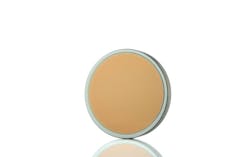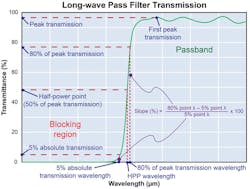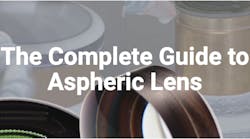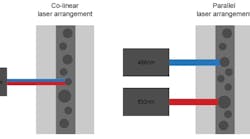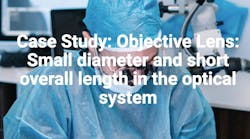Edge filters, also sometimes called dichroic filters, are coatings that include long wave pass and short wave pass filters. Specifically, these coatings transmit one range of wavelengths while blocking others. However, they are distinct from bandpass and notch filters in that they either pass wavelengths above (long wave pass) or below (short wave pass) a given single wavelength value, rather than a limited band of wavelengths within a range.
DSI LONG/SHORT WAVE PASS APPLICATIONS
- Laser systems
- Projection systems
- Spectroscopy and fluorescence imaging
- Military imaging, target designation and countermeasures
- Hyperspectral sensors
THE DSI DIFFERENCE
DSI custom manufactures a wide selection of edge filters for use at wavelengths ranging from the ultraviolet through the long-wave infrared. The designs can be optimized for various performance characteristics, including high in-band transmission, strong out-of-band blocking, polarization insensitivity, and sharp transitions between the passband and blocking region. DSI edge filters are distinguished by excellent durability with no wet/dry shift.
SPECIFYING COST EFFECTIVE EDGE FILTER COATINGS
When specifying edge filters, it’s useful to understand some of the most common design and production tradeoffs in order to avoid writing specifications in a way that drive up cost unnecessarily. Some of the key specifications for edge filters are the half-power point (HPP) placement tolerance, slope steepness, and blocking requirements. The graph here shows how these are defined.
OUT-OF-BAND BLOCKING VS. COST
High absolute out-of-band blocking specifications (greater than OD3, or <0.1%) are costly because these require “over designing” the blocking region to ensure there are no possibilities ofleaks. In contrast, an equivalent tolerance on average blocking is much easier, and therefore less expensive, to achieve.
It’s also important to realize that there is a key difference between the blocking characteristics of the typical longwave and shortwave pass filters. Specifically, the blocking range on longwave pass filters generally extends from the nominal blocking point all the way to X-rays. Similarly, the passband extends to wavelengths at which the substrate or coating materials themselves become opaque. In contrast, the blocking band for shortwave pass filters is usually limited and the optic eventually begins to transmit again. This is shown in the graphic. Attempts to extend the blocking range farther can compromise transmission in the passband. Thus, if an application requires extended out-of-band blocking, it’s better to design it to utilize longwave pass filters, rather than shortwave pass filters, or to incorporate wavelength specific absorbing substrates into the design in addition to the edge filter coating.
